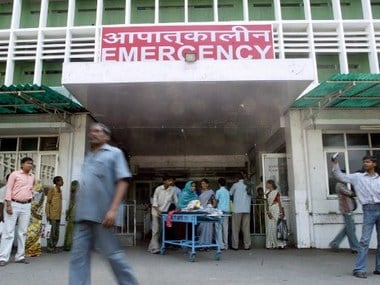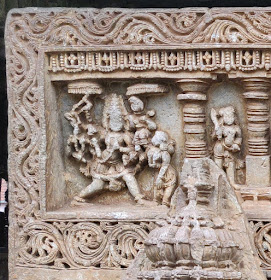Challenges, opportunities in India's $81b healthcare industry
India added 450 million people over the 25 years to 2016, a period during which the proportion of people living in poverty fell by half. This period of rising prosperity has been marked by a "dual disease burden", a continuing rise in communicable diseases and a spurt in non-communicable or "lifestyle" diseases, which accounted for half of all deaths in 2015, up from 42 percent in 2001-03.
The result of this disease burden on a growing and ageing population, economic development and increasing health awareness is a healthcare industry that has grown to $81.3 billion (Rs 54,086 lakh crore) in 2013 and is now projected to grow to 17 percent by 2020, up from 11 percent in 1990.
As that happens, in rural areas, mobile technology and improved data services are expected to play a critical role in improving healthcare delivery. Although limited, some companies are also investing in innovative services and creating lucrative yet low-cost digital and device solutions, an example of which would be GE Healthcare's Lullaby Baby Warmer.
However, despite some advances, India's healthcare sector must deal with a plethora of challenges.
With the lowest government spend and public spend, as a proportion of gross domestic product (GDP), and the lowest per capita health spend — China spends 5.6 times more, the US 125 times more — Indians met more than 62 percent of their health expenses from their personal savings, called "out-of-pocket expenses", compared with 13.4 percent in the US, 10 per cent in the UK and 54 per cent in China.
India's existing infrastructure is just not enough to cater to the growing demand.
While the private sector dominates healthcare delivery across the country, a majority of the population living below the poverty line (BPL) — the ability to spend Rs 47 per day in urban areas, Rs 32 per day in rural areas — continues to rely on the under-financed and short-staffed public sector for its healthcare needs, as a result of which these remain unmet.
Moreover, the majority of healthcare professionals happen to be concentrated in urban areas where consumers have higher paying power, leaving rural areas underserved.
India meets the global average in the number of physicians, but 74 percent of its doctors cater to a third of the urban population, or no more than 442 million people, according to a KPMG report.
India compares unfavourably with China and the US in the number of hospital beds and nurses. The country is 81 percent short of specialists at rural community health centres (CHCs), and the private sector accounts for 63 per cent of hospital beds, according to government health and family welfare statistics.
Some of the key roadblocks, then, for India's healthcare industry:
Population: India has the world's second-largest population, rising from 760 million in 1985 to an estimated 1.3 billion in 2015.
Infrastructure: The existing healthcare infrastructure is just not enough to meet the needs of the population. The central and state governments do offer universal healthcare services and free treatment and essential drugs at government hospitals. However, the hospitals are, as we said, understaffed and under-financed, forcing patients to visit private medical practitioners and hospitals.
Insurance: India has one of the lowest per capita healthcare expenditures in the world. Government contribution to insurance stands at roughly 32 percent, as opposed to 83.5 percent in the UK. The high out-of-pocket expenses in India stem from the fact that 76 percent of Indians do not have health insurance.
Rural-urban disparity: The rural healthcare infrastructure is three-tiered and includes a sub-center, primary health centre (PHC) and CHC. PHCs are short of more than 3,000 doctors, with the shortage up by 200 per cent over the last 10 years to 27,421.
There are, however, potential catalysts to improve the quality of healthcare in India.
The Union Budget 2017-18 includes measures to boost rural development, infrastructure and macroeconomic stability, and although the health budget has been increased 27 percent, allocations could have been matched more holistically with the government's ambitions, particularly when considering adjustment against inflation and new health programme announcements.
Analysts argue that the national insurance scheme (the Rashtriya Swasthya Suraksha Yojana) is a minor improvement on the existing one, with the annual limit per family increased from Rs 30,000 to Rs 1,00,000, with an additional "top-up" of Rs 30,000 for senior citizens. Our estimates suggest that enrolling all BPL families in the country in health-insurance programmes would cost anywhere from Rs 2,460 crore to Rs 3,350 crore, or less than the cost of two French Rafale fighters.
Information Technology (IT) is set to play a big role with IT applications being used for social-sector schemes on a large scale. Hospitals empaneled under the government insurance scheme are IT-enabled and connected to servers in districts. Beneficiaries can use a smart card that allows them to access health services in any empaneled hospital.
Additionally, several new computer and mobile-phone based e-health and m-health initiatives were launched on World Health Day in 2016. These include the Swastha Bharat mobile application for information on diseases, symptoms, treatment, health alerts and tips; ANMOL-ANM online tablet application for health workers, e-RaktKosh (a blood-bank management information system) and India Fights Dengue.
Individual states are adopting technology to support health-insurance schemes. For instance, Remedinet Technology (India's first completely electronic cashless health insurance claims processing network) has been signed on as the technology partner for the Karnataka Government's recently announced cashless health insurance schemes.
As technology increasingly plays an important role in healthcare, the data indicate growing attention from private investment and start-ups.
The government's National Innovation Council, which is mandated to provide a platform for collaboration amongst healthcare domain experts, stakeholders and key participants, should encourage a culture of innovation in India and help develop policy on innovations that will focus on an Indian model for inclusive growth.
Additionally, there has also been an emergence of "frugal innovation" in the private sector — products and business models that offer quality diagnostics and care at a much more affordable price.
Healthcare delivery in India is now uniquely poised to undergo a change at all its stages — prevention, diagnosis, and treatment. No single entity in the healthcare sector can work in isolation.
The evolution of the sector calls for involvement from all stakeholders and the use of innovation to bridge intent and execution. India has the opportunity to leapfrog a lot of the healthcare problems that developed nations are grappling with, such as unlinked electronic medical records and overspending.
The question is, can she seize the opportunity?


























































































